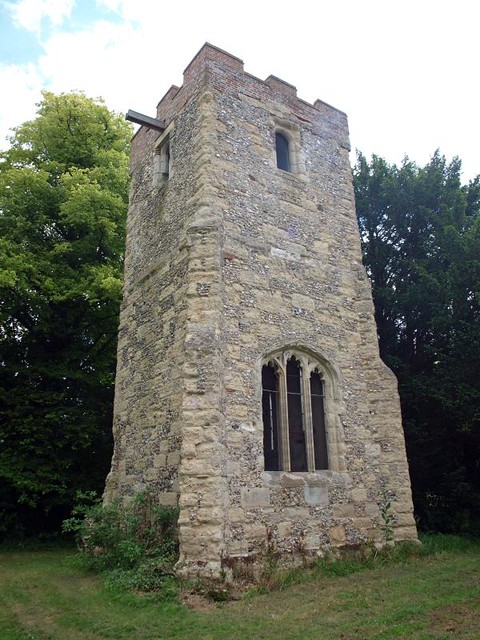I think I'm on record as stating that I love this underrated county but it must be said that The Chilterns are Hertfordshire's best kept secret - the countryside in these parts is simply stunning and there are some lovely villages and churches round here.
Sadly All Saints (LNK) isn't one of them. A very dull utilitarian Victorian building although after reading Pevsner perhaps the interior might lift it out the bland.
The tower of the old church is a treat.
Of the medieval church only the W tower remains, hidden by trees. It is of flint and stone-chequer work and has no buttresses. The date is C15.
The new church of ALL SAINTS is by Carpenter & Ingelow, 1882, without a tower, quite modest, but well designed with Dec details. In it a large number of medieval fragments are re-used or displayed. The aisle piers are those which stood in the parish church at Tring until 1880 (a fine late C15 design). In the N wall is an early C14 window, then a Norman arch with shafts and dog-tooth ornament of the voussoirs, then a C13 window of two lancets, and then various small fragments. The PULPIT is ordinary early C17 work, the very renewed SCREEN at the E end of the S aisle dated originally from the C15.
Long Marston. It lies in a corner of the county almost ringed round by Buckinghamshire, with a new church (1882) which has preserved many features brought from the old one. It has 15th-century clustered columns from the parish church of Tring built into its new arcade and the south doorway has stones marked with pilgrim’s crosses 600 years old. In the chapel is a recess with a Norman arch on Norman pillars, and the chancel has a 13th-century recess and a 14th-century piscina. Some of the aisle windows have their old stonework, and the screen has some 15th-century tracery and panels with a little of their ancient colour. Up in the roof between the nave and chancel is a fine beam 500 years old, with carved spandrels, and in the nave is the plain 600-year-old font. The 15th-century tower of the old church with two scratch dials on its walls, stands solitary not far away.
It was this village which witnessed the last witch tragedy in England, a terrible event involving three deaths. The law against witchcraft had been repealed years before as the result of a jury’s decision in this county, but in 1751, a mob at Long Marston went out of its senses and dragged from their homes two harmless old people over 70, Ruth Osborne and her husband John. It was said that a farmer’s misfortunes had been caused by Ruth, and notice was given by the town crier that these old people were to be tried by ducking. The old folk hid in the vestry of the church, but were dragged out and stripped, their hands tied to their toes, and so thrown into the pool, naked. The old woman died choked with mud, and she was tied to her husband, who died soon after. The authorities resolved that stern notice must be taken of this outrage, and a chimney-sweep who had been a ring-leader of the mob was charged with wilful murder. He was Thomas Golley, and was tried at Hertford assizes and sentenced to death, being executed next morning at Gubblecote Cross, Tring, where he was afterwards hung in chains.
It is odd that two Hertfordshire villages (this and Walkern) should be so dramatically associated with the ending of the witchcraft craze.
It was this village which witnessed the last witch tragedy in England, a terrible event involving three deaths. The law against witchcraft had been repealed years before as the result of a jury’s decision in this county, but in 1751, a mob at Long Marston went out of its senses and dragged from their homes two harmless old people over 70, Ruth Osborne and her husband John. It was said that a farmer’s misfortunes had been caused by Ruth, and notice was given by the town crier that these old people were to be tried by ducking. The old folk hid in the vestry of the church, but were dragged out and stripped, their hands tied to their toes, and so thrown into the pool, naked. The old woman died choked with mud, and she was tied to her husband, who died soon after. The authorities resolved that stern notice must be taken of this outrage, and a chimney-sweep who had been a ring-leader of the mob was charged with wilful murder. He was Thomas Golley, and was tried at Hertford assizes and sentenced to death, being executed next morning at Gubblecote Cross, Tring, where he was afterwards hung in chains.
It is odd that two Hertfordshire villages (this and Walkern) should be so dramatically associated with the ending of the witchcraft craze.


No comments:
Post a Comment